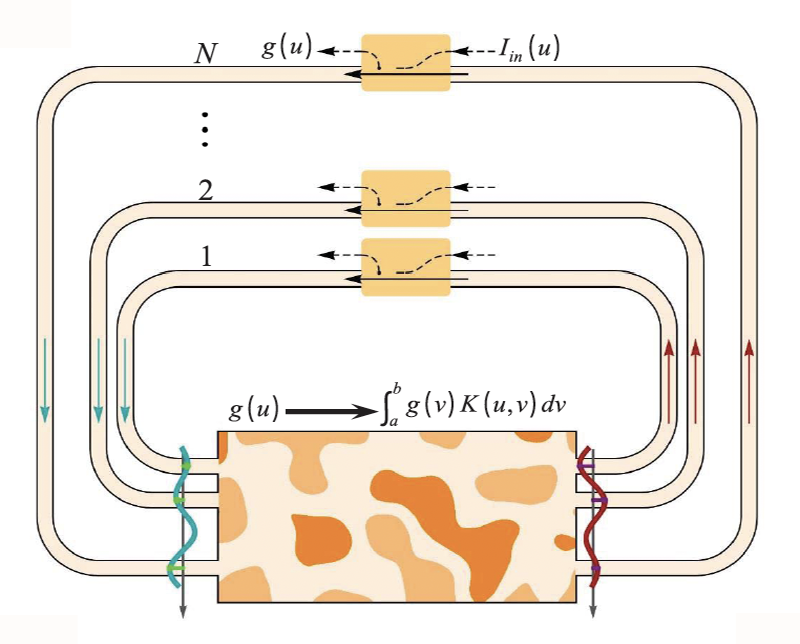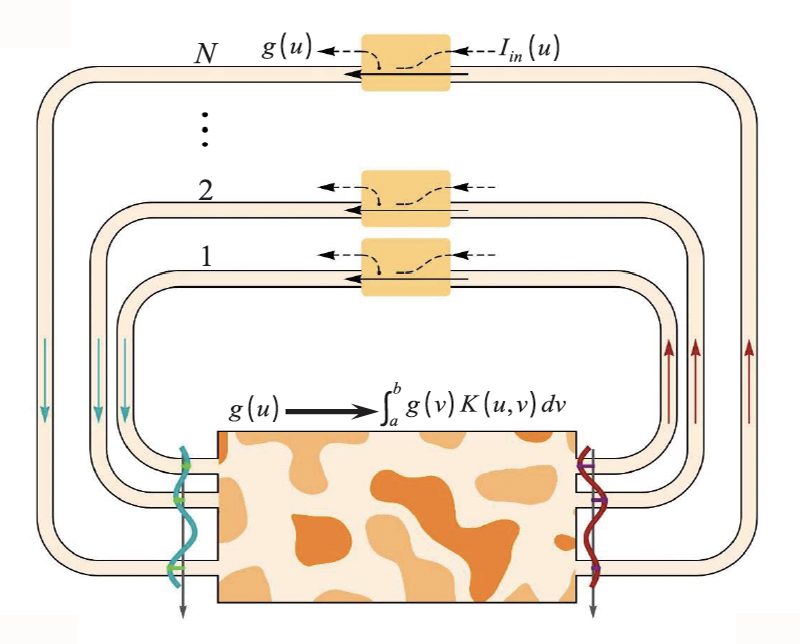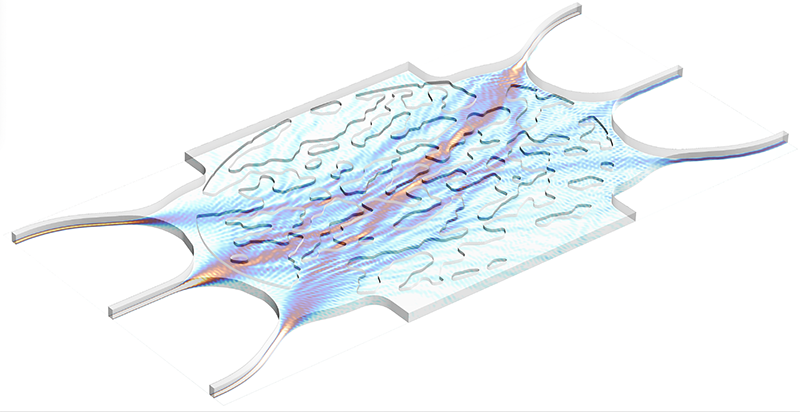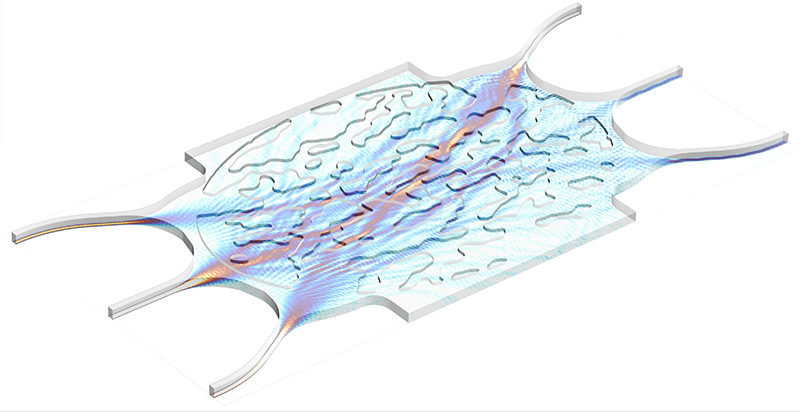Metamaterials for Analog Optical Computing
The idea of an analog computer—a device that use continuous variables rather than zeros and ones—may evoke obsolete machinery, from mechanical watches to bombsight devices used in World War II. But emerging technologies, including AI, may reap great benefits from this computing approach. A promising direction involves analog computers that process information with light rather than with electrical currents. As reported at the 2024 APS March Meeting by Nader Engheta of the University of Pennsylvania, composite media known as metamaterials offer a powerful platform for building analog optical computers. In recent work, his team demonstrated a metamaterial platform that could be mass produced and integrated with silicon electronics [1], as well as an approach for building architectures that could be reprogrammed in real time to perform different computing tasks [2]. Metamaterial-based analog optical computers may one day perform certain tasks much faster and with less power than conventional computers, says Engheta.
Metamaterials are synthetic materials made by assembling many units that are each smaller than the wavelength of the light they are designed to manipulate. They can be tailored to display properties not found in naturally occurring materials, most famously, a near-zero or negative refractive index. These exotic properties can enable unique applications, from subwavelength imaging to invisibility cloaking.
The design flexibility of metamaterials inspired several groups to explore strategies for turning them into computing machines. In 2014, Engheta and collaborators put forward a first set of proposals. Their simulations suggested that metamaterials could realize a suite of mathematical operations, including differentiation, integration, and convolution. The approach involves taking an electromagnetic wave as an input function and manipulating it through interaction with the metamaterial so that the output wave corresponds to a desired mathematical transformation of the input.
Five years later, Engheta’s group realized this proposal experimentally. Working at microwave wavelengths, their scheme involved a block of a metamaterial with several input and output ports connected by waveguides in a feedback loop. The experiments demonstrated that, for a given input, the device’s output was the solution of the so-called Fredholm integral equation, which is used in fields as diverse as fluid mechanics, antenna design, and quantum-mechanics perturbation theory. To pick the metamaterial structure realizing the desired math, the researchers used “inverse design”—an iterative approach for solving optimization problems. The resulting metamaterial had a nontrivial “Swiss-cheese” structure, with an inhomogeneous distribution of small islands with different dielectric properties—air holes, polystyrene, and microwave-absorbing materials.
Since microwaves imply bulky, impractical setups, several research groups set out to extend similar concepts to optical frequencies, demonstrating a variety of computing schemes. Most of these demonstrations used subwavelength-thin sheets of metamaterials, known as metasurfaces, to manipulate light propagating in free space and transmitted through the sheet. Metasurface schemes, however, require sophisticated, customized fabrication processes, which limits the potential for mass production, says Engheta.
Engheta and his colleagues have now developed an on-chip platform that may overcome such limitations [1]. Unlike metasurface schemes with free-space light propagation, the team’s metamaterial design channels light through structured waveguides on a silicon chip. The researchers inverse designed and built a micron-sized chip with a structure reminiscent of their 2019 microwave design: a set of waveguides feeding light into and out of a flat cavity containing a Swiss-cheese-like metamaterial. Such a structure can be simply ordered from commercial foundries, says Engheta. Compared to its microwave cousin, the optical chip does simpler math—it multiplies a vector by a matrix, an operation useful for AI tools such as neural networks. To solve equations, the scheme will need to incorporate feedback waveguides linking outputs to inputs, as was done in the microwaves, an engineering challenge that the team plans to address in next-generation chips.
In parallel to the optical work, Engheta is pushing the mathematical abilities of analog computers using proof-of-principle devices at lower frequencies. The group’s latest result added an important new feature: reconfigurability—the ability of an equation solver to be reprogrammed to perform different math. The scheme consisted of a 5 × 5 module of radio-frequency (45-MHz) elements such as amplifiers and phase shifters. The device could be reconfigured by controlling the parameters of each of the elements. As a demonstration, the researchers had their machine solve two different problems: finding the roots of a system of polynomials and performing the inverse design of a metastructure. Both problems are nonstationary, that is, they require a sequence of steps with different math operations at each step.
Engheta envisions that this reconfigurability feature could ultimately be carried over to the silicon-photonics chips. One approach for doing so would involve depositing a patterned layer of a “phase-change” material on top of the device’s waveguides. When heated, such a material changes its index of refraction, affecting light propagation in the waveguides and thereby the mathematical operator that such propagation encodes.
The programmable, metamaterial silicon-photonics chip would be a boon for analog optical computing, says Engheta, processing information at the speed of light with a fraction of the energy needed to power the millions of operations that a conventional digital processor needs to perform to solve the same tasks. “Here, light goes through a waveguide labyrinth, and when it comes out, you get the answer in one shot,” he says. And since photons, unlike electrons, don’t interact with each other, parallel operations could be carried out simultaneously simply by shining light at different wavelengths through the device. What’s more, such a device would have privacy benefits, because it does not require intermediate steps that store information into a potentially hackable memory, says Engheta.
–Matteo Rini
Matteo Rini is the Editor of Physics Magazine.
References
- V. Nikkhah et al., “Inverse-designed low-index-contrast structures on a silicon photonics platform for vector–matrix multiplication,” Nat. Photon. (2024).
- D. C. Tzarouchis et al., “Programmable wave-based analog computing machine: A metastructure that designs metastructures,” arXiv:2301.02850.







